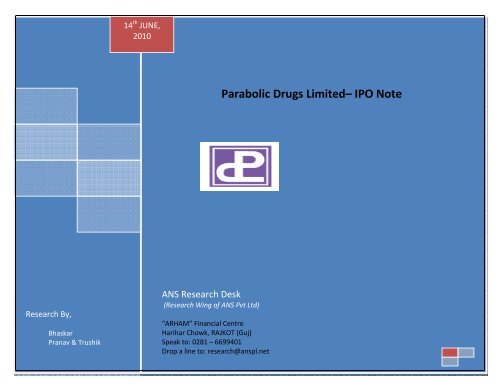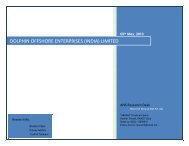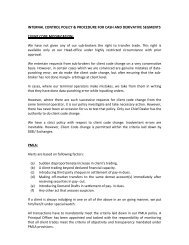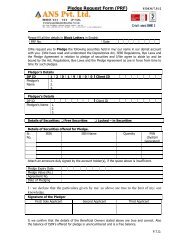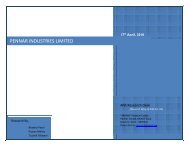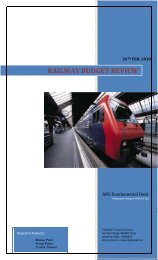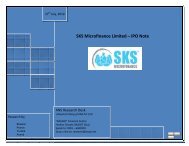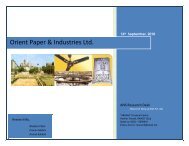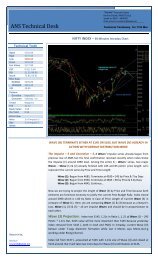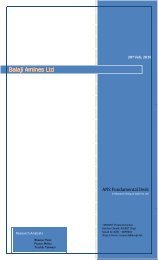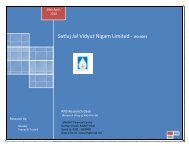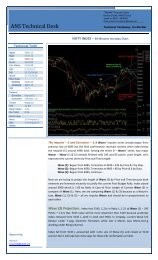Parabolic Drugs Limited– IPO Note - ANS Pvt. Ltd.
Parabolic Drugs Limited– IPO Note - ANS Pvt. Ltd.
Parabolic Drugs Limited– IPO Note - ANS Pvt. Ltd.
- No tags were found...
You also want an ePaper? Increase the reach of your titles
YUMPU automatically turns print PDFs into web optimized ePapers that Google loves.
Issue DetailsSectorPharmaceuticalIssue Size 26,666,667QIBs * 13,083,334Non-Institutional* 3,925,000Retail* 9,158,333Face Value Rs. 10Price Band # Rs. 75-85BRLMsAvendus CapitalICICI Securities <strong>Ltd</strong>SPA MerchantRegistrarLink Intime IndiaCompany Address:Corporate Office9AB, Taimoor Nagar,New Friends Colony,New Delhi 110 065,India.Tel: + (91 11) 6517 6840Fax: + (91 11) 2633 2660Website: www.parabolicdrugs.com* Minimum allotmentRATINGS: CARE has given an <strong>IPO</strong> rating of GRADE 2 to the issue suggesting belowaverage fundamentals for the company, and BRW has given an <strong>IPO</strong> rating ofGRADE 3 to the issue suggesting average fundamentals for the company.<strong>Parabolic</strong> <strong>Drugs</strong> Limited is one of the fast growing API (Active Pharmaceutical Ingredients) andAPI intermediate manufacturing and marketing company in the SME segment, with increasinginternational presence and a strong R&D foundation, based at Chandigarh, India.Commissioned in 1998, PDL has two fully functional, state of the art manufacturing units, aWHO-GMP certified Unit based in Derabassi (Punjab) and a USFDA accredited manufacturingplant at Panchkula, (Haryana) respectively.Over the decade, PDL’s management has created a scalable business model in the API & APIIntermediates segment to offer a product basket of Semi Synthetic Penicillin’s (oral & Sterile)and Cephalosporin’s (oral) and Cephalosporin Sterile. The Company commissioned a 6-APAfacility at Panchkula, Haryana in FY 2005 which is approved by USFDA for supply of the productto US Markets.PDL has consistently registered a growth rate of 70% on year on year basis over the last threeyears, both in its top line and bottom line. The company has managed to maintain its EBIDTA at15% in last three years during this period.This phenomenal growth has been driven by a vision of INR 1000 Crores, Global API and CRAMSCompany by the year 2011-2012 under the chairmanship of Mr. Pranav Gupta, a young anddynamic first generation entrepreneur. The Company has set forth huge expansion plansincluding inorganic growth and foray into Custom synthesis & Contract Manufacture.PDL’s long-term strategy includes expanding product basket to include Cephalosporin (Sterile)to its existing portfolio and become a preferred supplier to large global pharmaceutical playersfor supplying APIs and API intermediates in the regulated markets of US and Europe. TheCompany has recently commenced its CRAMS business and is fast expanding its marketpenetration in the Middle East & European markets, in both API and CRAMS segments.PDL is moving step by step, in a phased manner to be able to achieve its Vision of being a worldclass supplier of API and Custom synthesis services of the highest quality.
The net issue proceeds will be used for following objectives:The Net Proceeds of the Fresh Issue are proposed to be utilized by us for financing thefollowing objects:1. Multi-purpose Block III at Derabassi;2. Sterile cephalosporin plant at Derabassi;3. Establishment of Chachrauli plant;4. Investment in our Subsidiary;5. Repayment / prepayment of identified loan facilities; and6. General corporate purposes.Source: Company RHP
INDUSTRY OUTLOOKINDIAN PHARMACEUTICAL INDUSTRYThe Indian pharmaceutical industry can be classified based on products manufactured as ‘bulk’actives and ‘formulations’. Based on the markets catered, these can be further classified intodomestic and exports. Further, exports can be made to regulated or developed markets like US,Europe, Japan etc and semi-regulated/non regulated or emerging markets like Asia, Africa andLatin America.Bulk actives are otherwise known as Active Pharmaceutical Ingredients (APIs) or bulk drugs.They comprise medicinally active ingredients that are converted into formulations or dosageforms. APIs are either manufactured in-house by formulation companies or they can beoutsourced to third party API manufacturers. Formulations involve developing a preparation ofthe drug (from APIs and other ingredients) which is both stable and acceptable to the patient.This usually involves incorporating the drug into a tablet, capsules, injectibles, syrups, etc. Theformulations are administered to or taken by the patient and are available either byprescription or over-the-counter. A prescription drug is a licensed medicine that is regulated bylegislation to require a prescription (usually from a doctor) before it can be obtained. The termis used to distinguish it from over-the-counter drugs which can be obtained without aprescription.Strong GDP growth (8.5% in 2007-08, 9.4% in 2006-07 and 9.0% in 2005-06) and significant costadvantages have resulted in the Indian pharmaceutical industry growing significantly by 19.8%from around USD 6.9 billion in 2002-03 to around USD 17.0 billion in 2007-08. Indianparticipation in the international pharmaceutical market has increased and with more productsgoing generic in developed economies, Indian formulations and bulk drug exports have grownsignificantly. Also, increasing cost pressures on innovators has resulted in significant growth incontract research business. Driven by the above factors Indian pharmaceutical exports havegrown at a CAGR of 27.0% in the last six years to reach USD 8.6 billion in 2007-08.
According to the Ministry of Commerce, Report of the Task Force, December 2008, currently,the Indian pharmaceutical industry is one of the world’s largest and most developed, rankingfourth in volume terms and 13th in value terms. In the API segment, India ranks third in theworld producing about 500 different APIs. India has emerged as the country with the largestnumber of USFDA approved plants outside US. According to the Department of Industrial Policy& Promotion, the drugs and pharmaceuticals sector has attracted foreign direct investment(“FDI”) worth USD 121.8 million during the period April-October, 2009. The cumulative FDIinflows in this sector from April 2000 to October 2009 have been USD 1.58 billion.The Indian pharmaceutical industry is expected to grow at a CAGR of 14.2% to around USD 50billion in 2015- 16. Exports are expected to grow at a CAGR of 16.2% while the domestic marketis expected to grow by 12.5%.API manufacturers in India supply APIs to domestic formulation companies, which cater todomestic and/or export markets, and also export APIs directly to regulate and/or semiregulated/unregulated markets abroad.CONTRACT RESEARCH AND MANUFACTURING SERVICES INDUSTRYThe R&D and manufacturing outsourcing market (CRAMS) has two major segments – contract(custom) manufacturing services and contract research (drug discovery and development)services. Drug discovery and development outsourcing, also known as contract research, spanstarget identification and lead optimization to Clinical Trial IIa. Contract manufacturing, spansfrom clinical trial phase IIb to the off-patent stage and includes manufacturing of intermediates,APIs and formulations. Custom Synthesis (“CS”) forms an important business sub-segment ofCRAMS. CS entails synthesis of compounds, as per customer specification/requirements. Thus,it involves supplying initial material, reference compounds, derivatives of lead compounds andintermediates, especially for molecules in the development stage or drugs under patent.
The Indian CRAMS IndustryIndia is emerging as one of the most attractive destinations for outsourcing of globalpharmaceutical activities.The Indian CRAMS industry was valued at USD 1.7 billion in 2008. Despite India’s inherentadvantages, it accounts for only ~3% share of the USD 51 billion global outsourcing market,indicating significant opportunity for growth in this segment.Source: Company RHP
POSITIVES AND CONCERNS ABOUT THE COMPANYPositivesRobust GrowthThe company’s revenues have grown at a CAGR of more than 65% over last 4 years. Also, theproposed future expansion plans will result in continuous growth in top line of the company.High Asset TurnoverThe company asset turn over ratio is highest among its peers which allow PDL to manage itscapital efficiently.Exclusive ContractsThe company made a contract with Ranbaxy for two of its molecules, to provide bulk drugs.Such contracts with larger Pharma players could boost PDL’s earning prospects in coming years.Private Equity Firms partly exitThe two PE firms Alden Global and BTS India Private Equity are only taking a partial exit. Boththe PE firms remain invested which may signal possibility of generating higher returns in thenear future.
ConcernsNegative Operating Cash flowThe cash flow from operations for PDL has been negative over last few years. This may be a signlow lower cash flow generation from its business.High DebtThe company has higher debt than most of its peers, again showing signs of not enough cashflow generation to fund its expansions.Excess equity dilutionThe company has already diluted its equity 9 times in past 5 years. PDL does not seem to beable to have internal accruals to fund its expansion and growth. The promoter’s stake after theissue will reduce from 63% to 40%. Also, the two PE funds are selling just over 11% of theirstake. This is again, substantial dilution of equity. None of its peers have gone for such equitydilution for the same period.‘<strong>Parabolic</strong>’ name not registeredThe name and logo ‘<strong>Parabolic</strong>’ are not registered trademarks for the company. Themanagement does claim to have applied for the registration.Limited product portfolio and high competitionPDL manufactures semi synthetic penicillin (SSP) and cephalosporin range of antibiotics. Itsproduct portfolio comprises 44 APIs and 7 API intermediates. This space is highly competitiveand maintaining high margins will be very difficult. The company derived 100% of its grossincome (Rs374.52 crore) from the antibiotics category in the nine months ended December2009.Focus only on CRAMS and APIThe company till now has concentrated mainly on low margin CRAM and API products which donot provide any pricing power to them. Going forward also they don’t have any plans to moveinto branded products. So though concentrated business focus is a good thing but the industryitself is very competitive and so if they loose out some important customers than it will becomevery difficult for the company to operate in such a competitive environment.
Key takeaways from the <strong>IPO</strong> meeting (What the management said) Company exports its products to Turkey, Italy, Netherlands, Korea,European Union and U.S.A. The attrition rate in its R&D department is 5%. The company is currently has 85 Scientists in its Research Centre including16 PHD’s. The company has 487 customers. It is doing 40% exports and 60% domesticbusiness. It was doing 27.93% direct exports as of December 2009. The company is going to add approximately 80-90% additional capacitywithin next 1.5 years. PDL is currently having 10 patents - 1 International and 9 Indian. Average price realization per kg of their products is Rs. 2820/kg The company normally goes for hard sales contract with their customersand it recently did one with Ranbaxy for 2 molecules.
FINANCIAL HIGHLIGHTS1. Total income of the company has grown at a CAGR of 62% from 2007 to Mar 2009.2. Interest payment made by PDL has increased considerably, as the company has beingtaking on debts on regularly. The debt in Dec 09 is more than 5 times, the debt in Mar07.3. Cashflows of the PDL has been consistently negative and increasing over last few years.4. Also, the EPS of the company has been flat over last three years.Balance Sheet (Standalone Results)(Rs. In Lacs)Particulars Dec 2009 Mar 2009 Mar 2008 Mar 2007Total Funds 11171.13 10566.45 6230.98 3258.89Total Debts 36767.88 26402.80 15942 6966.25Cash & Bank Bal 1793.12 1350.61 734.99 307.04Total Assets 60891 4999.97 28558.16 14365.43Contingent Liability N.K. 86.72 55.59 21.03SOURCE: COMPANY RHP
Profit & Loss (Standalone Results)(Rs. In Lacs)PARTICULARS Dec 2009 Mar 2009 Mar 2008 Mar 2007Income 37452.39 42967.43 30025.49 16683.39Other Income 393.53 201.95 61.89 42.02Operating Income 35015 39693 27393 15056Total Expenditure 32220.90 37011.62 23915.22 13435.11Dep. & Amortization 405.35 360.86 182.55 52.57Interest 2956 2833 1192 589.2Tax 653.32 572.88 511.26 262.2PAT 2141.28 2109.20 2967.43 1358.98Diluted EPS(after bonus issue) 6.37 6.60 12.70 5.88SOURCE: COMPANY RHPCash Flow (Standalone Results)(Rs. In Millions)PARTICULARS Dec 2009 Mar 2009 Mar 2008 Mar 2007Cash From Operating Activities -939.28 -4036.87 -2724.31 -489.46Cash From Investing Activities -6026.54 -5617.93 -2643.57 -1266.98Cash From Financing Activities 7408.33 10270.41 8166.03 3143.71Net Cash Inflow/Outflow 442.51 615.61 427.65 10.68Opening Cash and Cash Equiv. 1350.61 734.99 307.04 296.36Closing Cash and Cash Equiv. 1793.12 1350.61 734.99 307.04SOURCE: COMPANY RHP
-Die Wirtschaftsgebäude: die Bauhäuser am BauhofDem inneren Stiftsbezirk war der landwirtschaftliche Bereich mit denBauhäusern, den Kutschenhäusern, den Gärten der Damen, derStiftsbleiche mit dem Waschhaus und dem Baumhof vorgelagert. Beiden Bauhäusern handelte es sich um landwirtschaftlichen Zweckendienende Gebäude. Sie wurden von Beschäftigten des Stiftsbewirtschaftet und dienten der Versorgung der Stiftsdamen. DieBauhäuser standen entlang der Hauptstraße.Vom Fahrtor aus ging es zwischen zwei Bauhäusern hindurchgeradeaus auf den Bauhof, einem besteinten Platz. Auf der linkenSeite folgten das Bauhaus der Fräulein von Nagel und dieKutschenhäuser einiger Stiftsdamen.Nach rechts zweigte ein Weg ab, der auf der Rückseite der Bauhäusernach Osten verlief und sowohl zu den Bauhäusern als auch zu denGärten der Damen, zum Baumgarten und zur Stiftsbleiche mit demWaschhaus führte.Das „Speck- und Bauamt des Hochadeligen Stifts“ verfügte übereigene Einnahmen für Neubauten, Reparaturen, Reinigungs- undSicherungsaufgaben. „Für Schließung der inwendigen Stiftstüren unddes eisernen Thors“ wurden z.B. um 1800 jährlich 4 ½ Reichstalerveranschlagt.-Die Versorgung derStiftsdamen und dieFräuleinhaushalteDas Damenstift versorgtesich weitestgehend selbst. Fürdie Produktion von Bier undBrot gab es das Back- undBrauhaus, in dem derSchlüter tätig war. ImStiftsgarten lagen zwei Speicher für die anzuliefernden Abgaben derBauern. Für die Versorgung von Stiftsbediensteten war eineGroßmagd in einem eigenen Haus tätig. Die auf Selbstversorgungeingerichteten Stiftsdamen ließen ihr Gemüse in ihren Gärtenheranziehen. Eine intensive Vorratshaltung kennzeichnet dieFräuleinshaushaltungen: Bohnen, Sauerkraut, Kartoffeln und andereswurden eingelagert. Aus den Abgaben der dem Stift zugehörigen Höfeerhielten die Stiftsdamen ihr Kontingent an Korn und anderen Gütern.Ihr Korn bewahrten sie in Kornkisten auf dem Boden desDormitoriums auf.Die landwirtschaftlichen Zwecken dienenden Gebäude des Stiftslagen wie ein Querriegel vor dem inneren Stiftsbezirk. DieStiftsmühle befand sich außerhalb des Stiftsbezirkes, Vechte abwärtshinter der Stadtbefestigung. Für die stiftseigene Viehhaltung besaßdas Stift die besten Weiden Metelens, den Falkenkamp, in der Hasseltgelegen. Die ehemalige Flurbezeichnung „Kälberkamp“ für das Arealdes alten Friedhofes lässt auf seine frühere Funktion für diestiftseigene Landwirtschaft schließen. Das Stift beschäftigte aucheinen Schäfer, der ein Schäferhaus bewohnte und für den großenBestand an Schafen Sorge zu tragen hatte. Das Stift war berechtigt,mehr als 200 Schafe zur Hude in die Mark zu treiben.1,2,3 Bauhäuser4 Baumhof5 Haus d. Großmagd6 Kutschenhäuser7 Nebenhaus8 Bleiche9 Gärten der Stiftsdamen10 Bauhof11 Dormitorium12
Disclaimer: The information being provided to you is compiled from sources we believe to be reliable. <strong>ANS</strong> <strong>Pvt</strong>. <strong>Ltd</strong> cannot and does not take any guaranteesabout the accuracy, reliability, validity or timeliness of the information and/or data provided/made available to you in this document. The views are purelyindicative. Neither <strong>ANS</strong>PL nor any of its associates, subsidiaries, affiliates, directors, and/or officials become liable or have any kind of responsibility for any lossor damage that you may incur from any decisions taken by you based on our recommendations. None of the information contained herein constitutes asolicitation from <strong>ANS</strong>PL to Buy and/or Sell securities and/or any Future, Options or Other Financial Contracts. Clients may exercise their own caution and doublecheck or verify the information contained in our recommendations.


